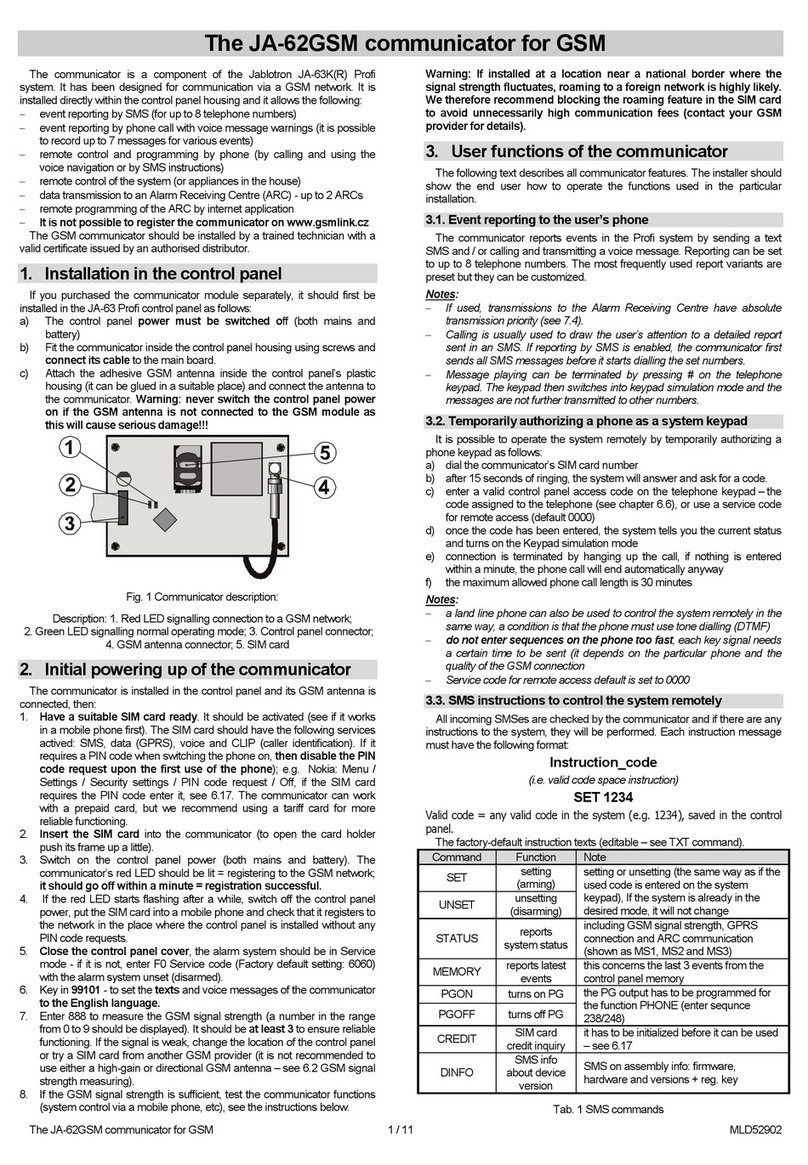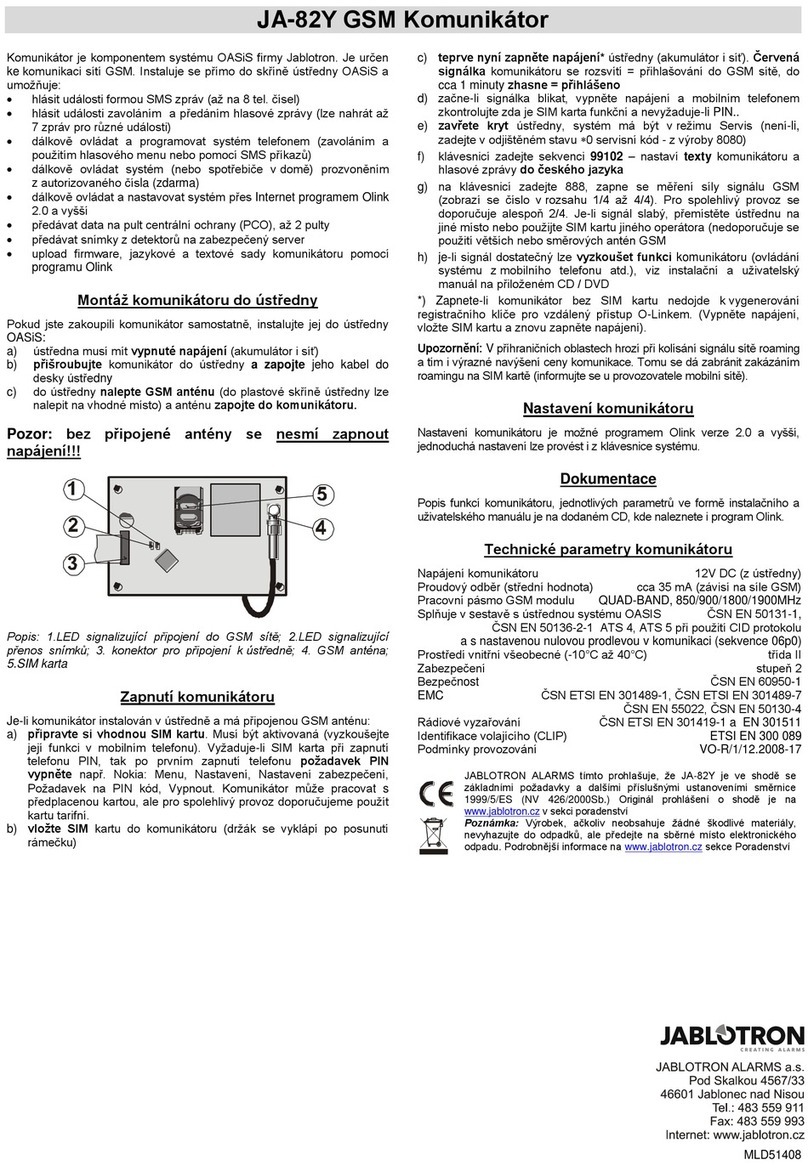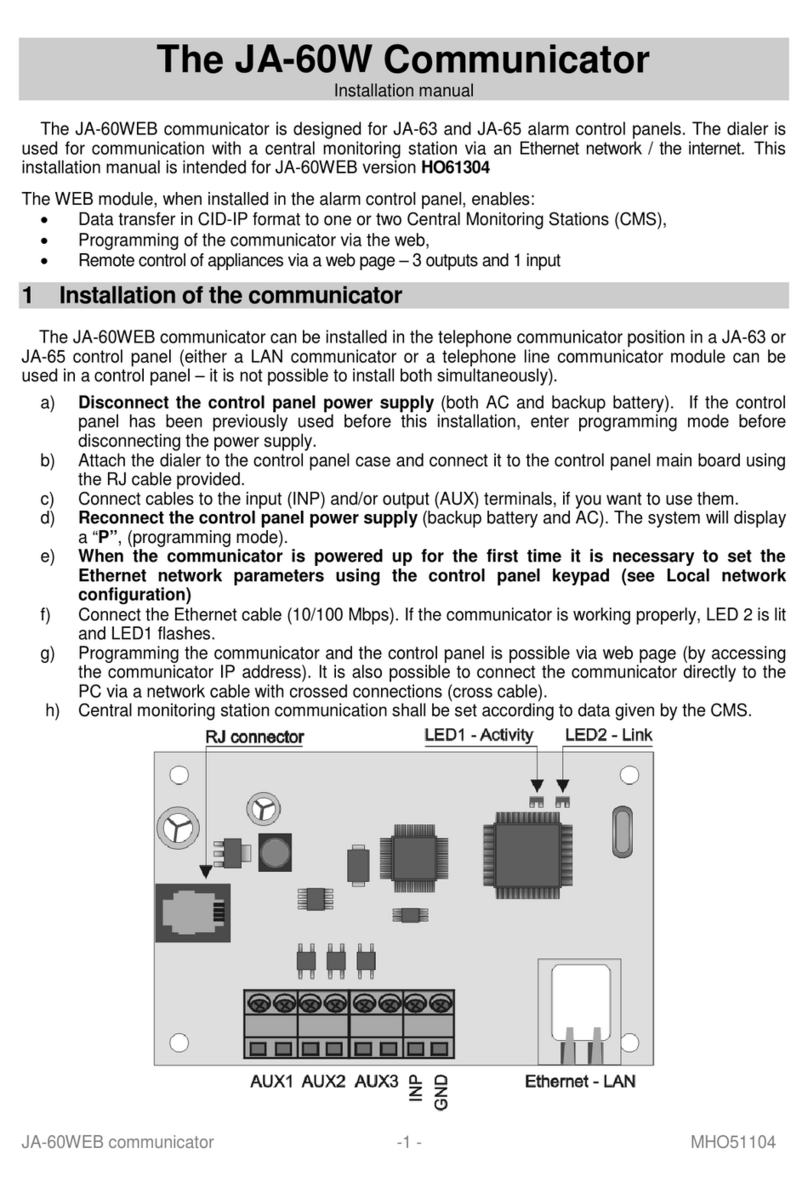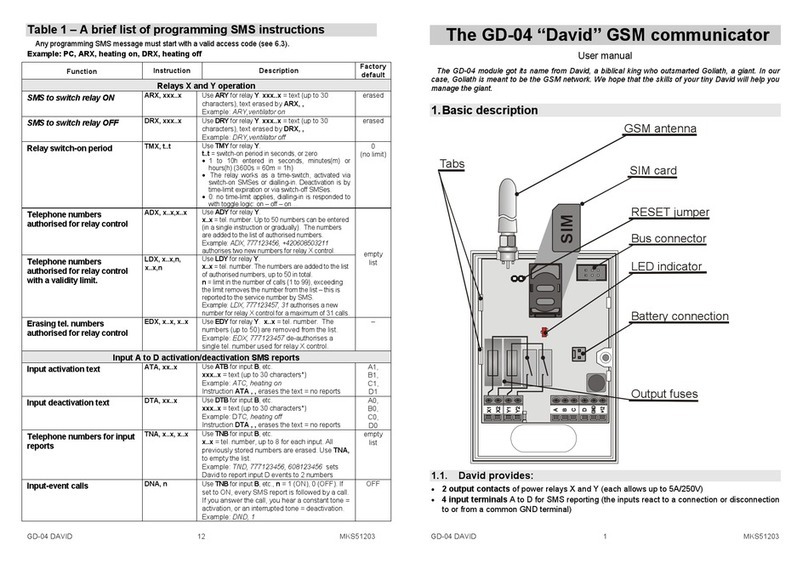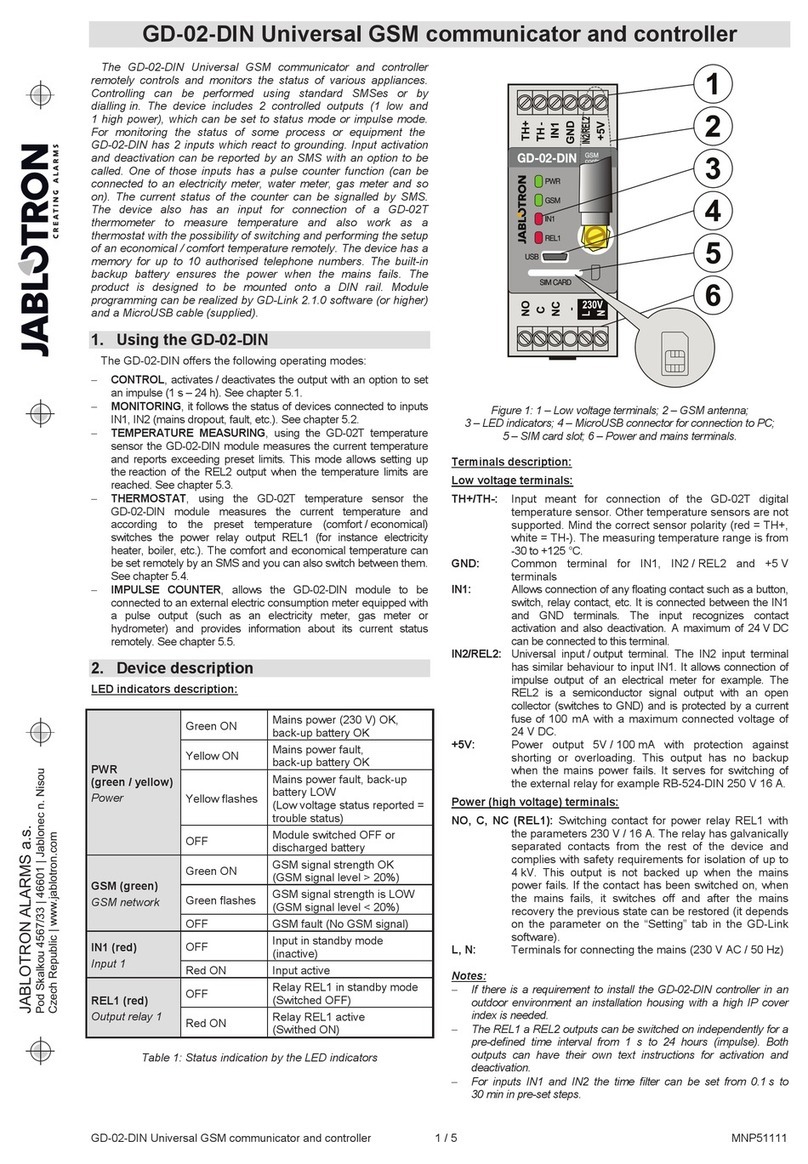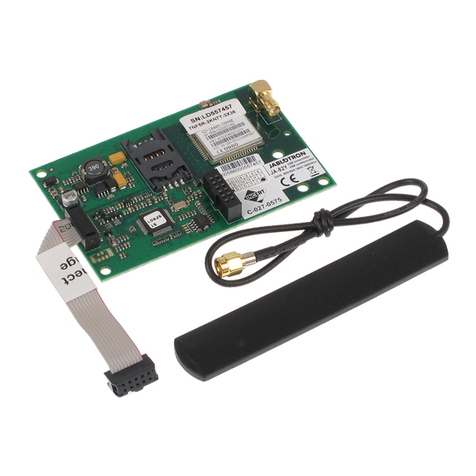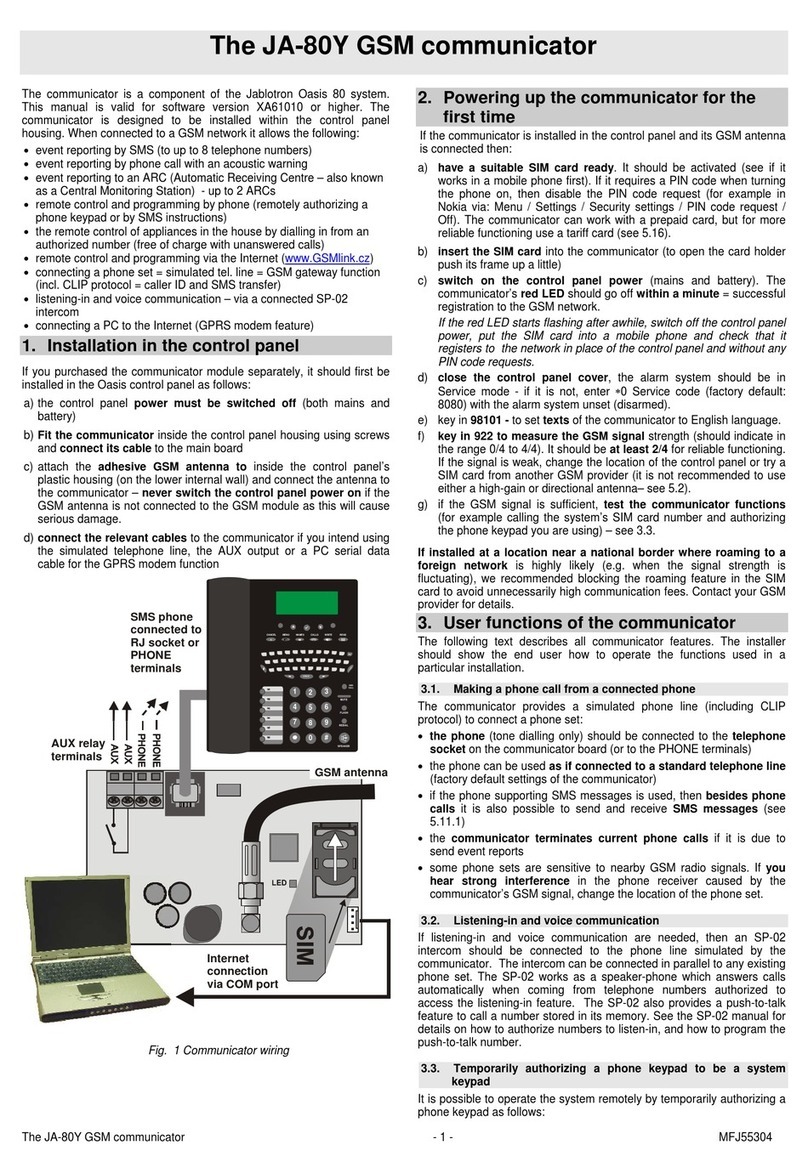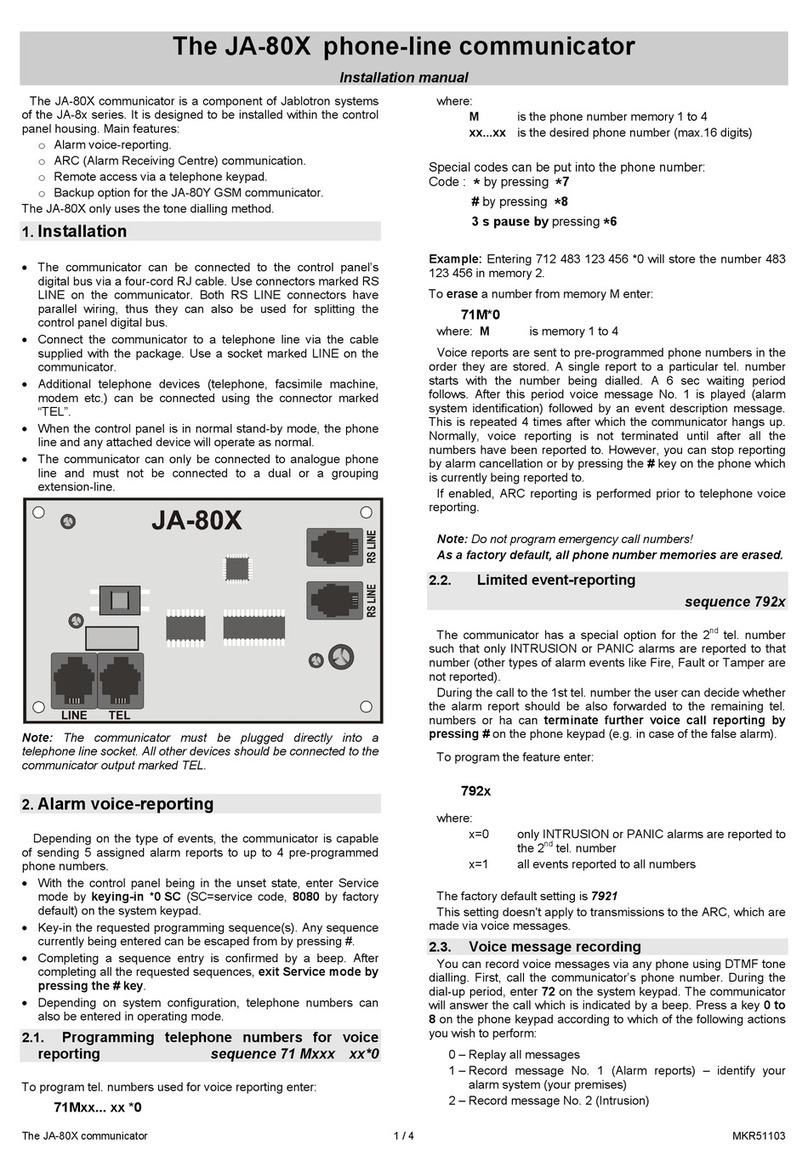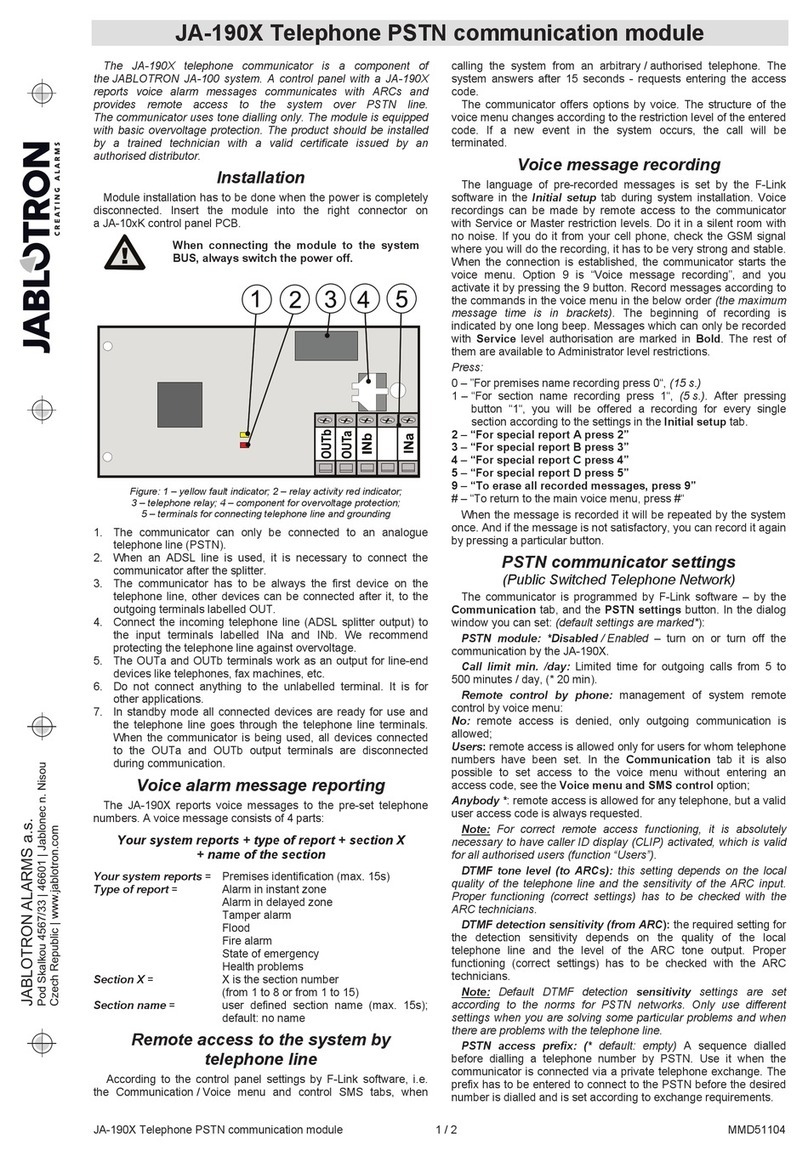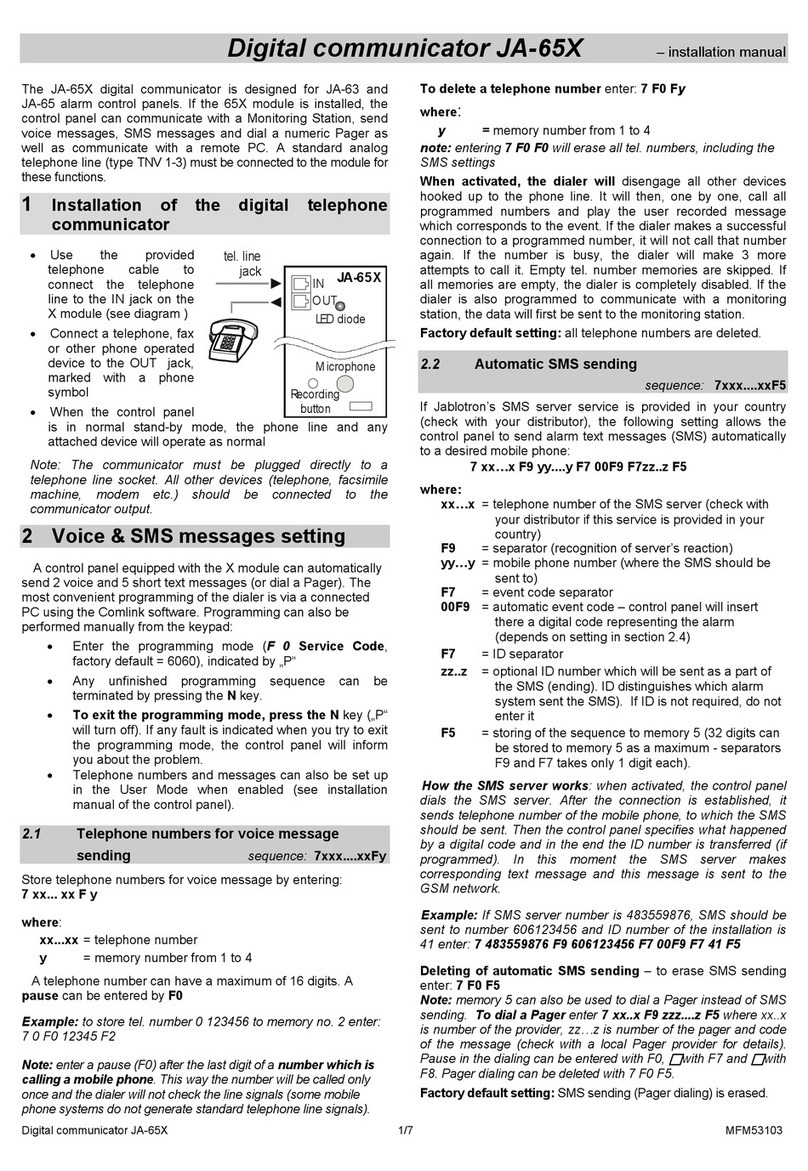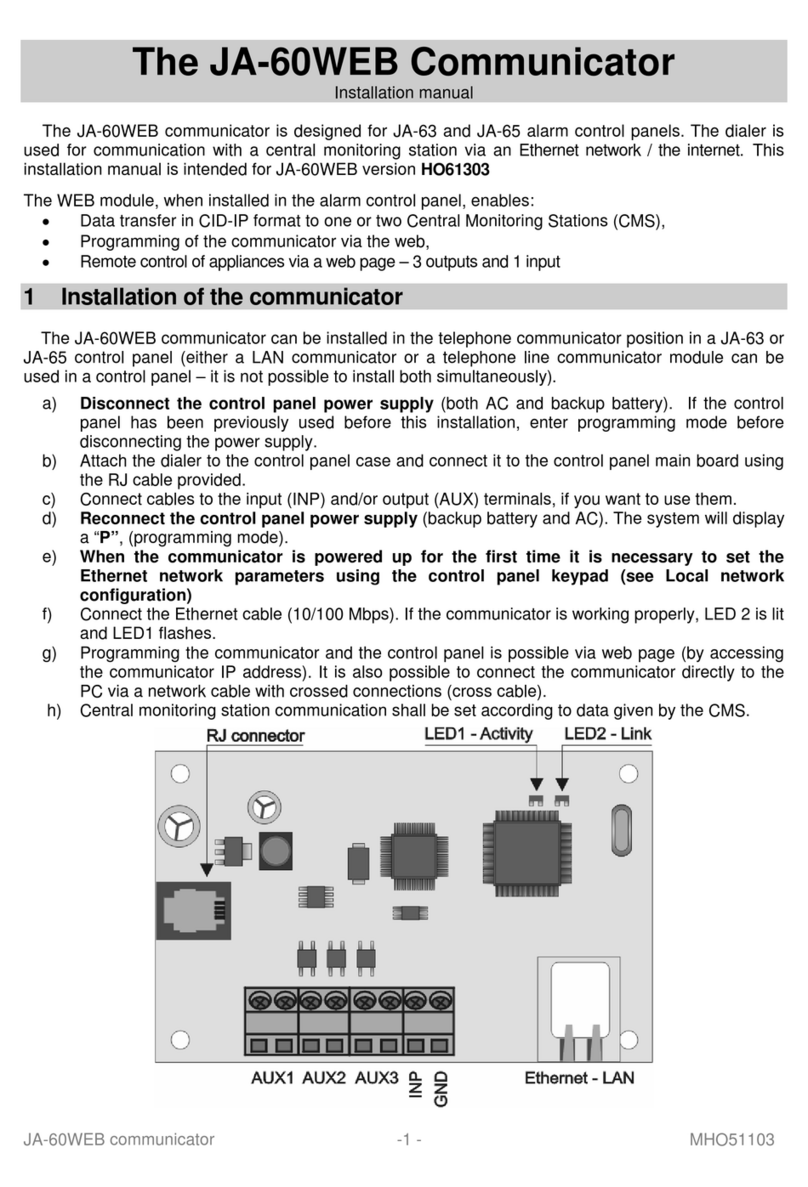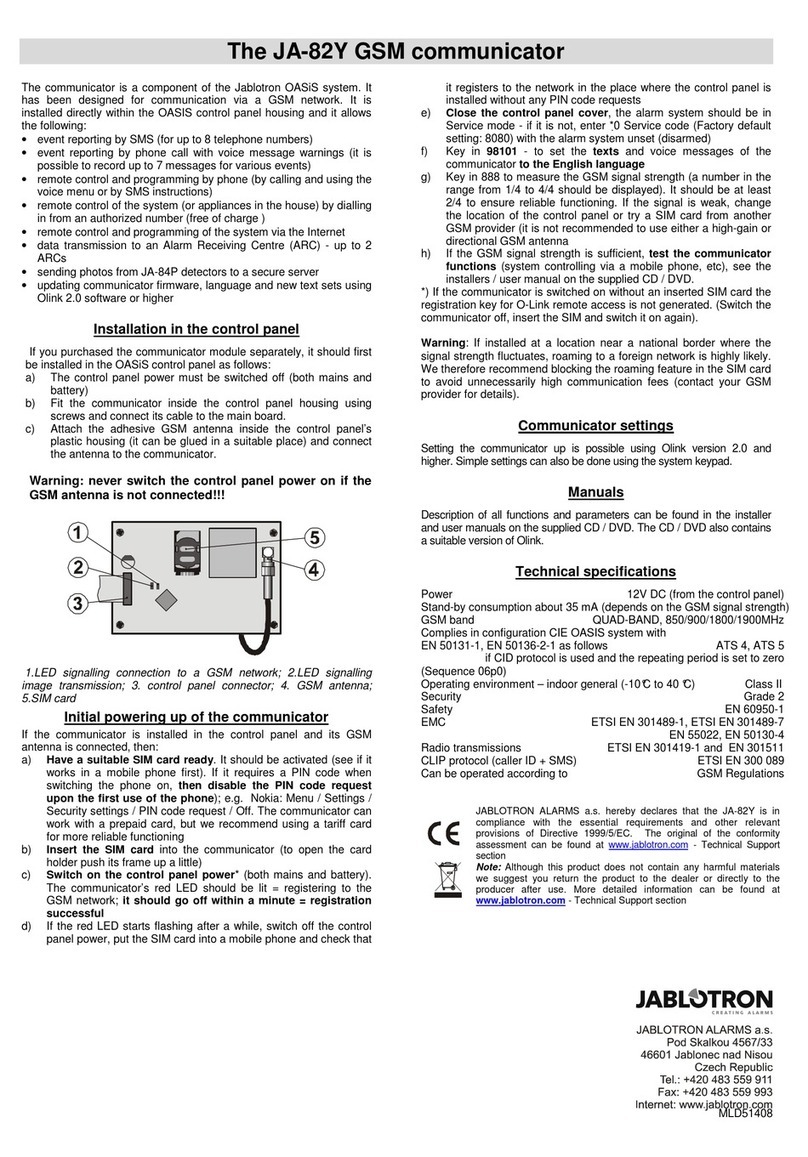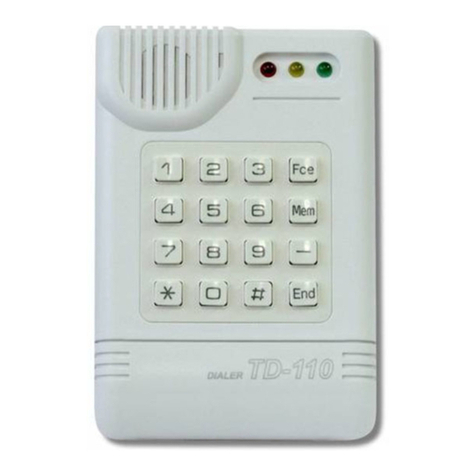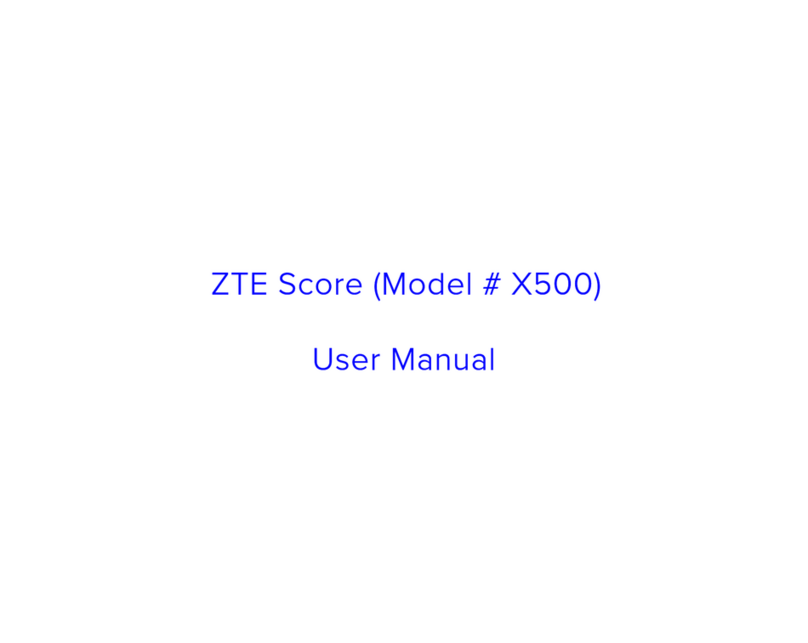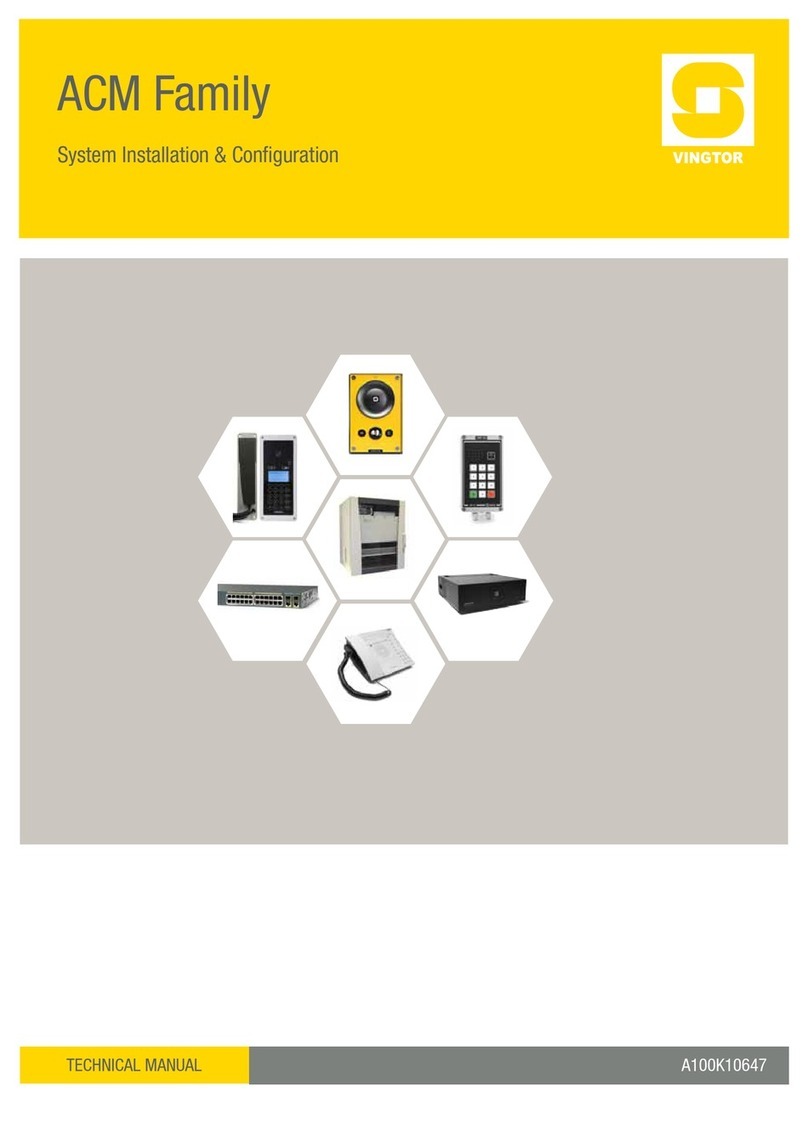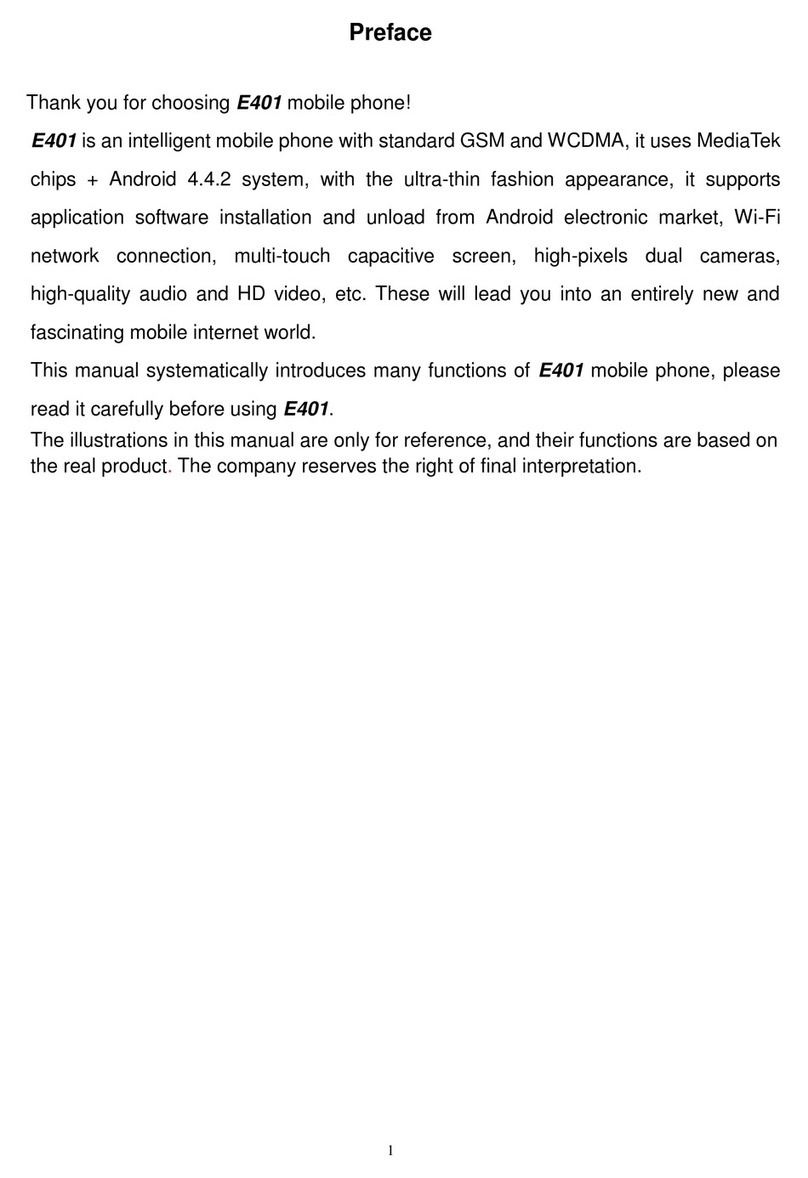The JA-80V LAN/PSTN line communicator - 9 - MKA51202
5.28. ARC communication checking period
The time to wait after the last re ort sent to an ARC before erforming
an ARC communication check is set by this sequence. The
communication-checking event code is 31 (see 5.26). This sequence
rograms how often the communication check is erformed:
07 a hhmm
where
a 1 = ARC1, 2 = ARC2
hh hours
mm minutes
Notes:
• Checking re orts are not sent in service mode
• IP CID rotocol allows very frequent checking of ARC
communication (e.g. every 5 minutes).
Factory default setting: 24 hours after the last report – for both ARCs
5.29. Enable ARC reporting (ARC2 backs up ARC )
This sequence allows re orting to ARCs to be switched on/off and also
enables ARC2 to backu ARC1:
00 a x
where
a 1=ARC1, 2=ARC2
x 0=off, 1=on, 2= ARC2 backs u ARC1 (2 can only be
entered for ARC2)
Note: if ARC2 backs u ARC1 then it will only receive data if it is not
ossible to deliver it to ARC1. A re ort containing “Communication
fault to ARC1” is then sent to ARC2 together with the first re ort to
ARC2.
Factory default setting: both ARCs = off
5.30. Recording reports sent to ARCs in the control panel
memory
This sequence enables the recording of every re ort successfully
communicated to ARCs in the control anel’s internal memory.
080 enabled
08 disabled
Note: it is recommended not to record re orts sent to ARCs but to
enable the indication of ARC communication faults (see 5.31). This
saves a significant amount of control anel memory. The system
initially assumes that every re ort is successfully delivered to ARCs,
but if a re ort is not successfully delivered within 110 seconds of
transmission, then a communication fault will be indicated and
recorded.
Factory default setting: enable
5.3 . Indicate an ARC communication fault if a report is not
successfully received within 0 sec of transmission
Enables the indication and recording of a communication fault if a
re ort is not successfully delivered to an ARC within 110 seconds of its
transmission.
090 communication faults not indicated
09 communication faults indicated
Notes:
• The communicator continues trying to send information to an ARC
even after a communication fault has been indicated (after the data
has been delivered, communication fault indication sto s).
• For communication-checking re orts the delivery time limit
(confirmation from the ARC) is 300 minutes. But if any other re ort is
sent to the ARC it must be confirmed within 110 seconds (otherwise
a communication fault will be indicated)
Factory default setting: communication faults not in icate
5.32. IP address for data transmission
The communicator su orts transmission of the s ecial data (e.g.
visual information for the img.jablotron.com ) from the system to set IP
address, which can be set by following sequence:
013 xx..x ∗0
where:
xxx...x is IP address and ort – set in format as shown in the
exam le:
0 3 ∗
∗∗
∗8 92 68 02 23 08080 ∗
∗∗
∗0
∗
∗∗
∗8 insert # character, to identify the IP address which must
consist of 12 digits followed by 5 digits of the ort
To erase the IP set 0 3∗
∗∗
∗0.
Factory default : IP address is set to 77.104.220.129 7070
(img.jablotron.com)
5.33. Locking the ARC settings
All settings which effect re orting to ARCs can be locked by a digital
code:
90 xx..x ∗
∗∗
∗0 where xx..x is an installer-defined locking code (4 to
8 digits)
Notes:
• Exiting service mode after the locking code has been entered will
lock all the settings effecting ARC communication (see the
sequence list in section 5).
• If ARC rogramming is locked, then it can be temporarily enabled
in service mode by entering 900 xx..x ∗
∗∗
∗0 where xx..x is the locking
code. It will then relock on exiting service mode.
• The ARC settings can be permanently unlocked by entering 901∗0
while ARC rogramming is tem orally enabled – see above. This
will erase the locking code.
Factory default setting: ARC settings unlocke
5.34. Engineer reset
The Engineer reset also requires the control anel firmware to be of
version KE60108 or higher. This feature is designed for ARC (Alarm
Receiving Centre) connection to satisfy the following requirements of
the DD243 standard: After a confirmed alarm has been triggered, the
control anel must switch to a disabled state. Switching to normal
o eration is then only ossible using a valid ARC access code. Until
then, the system remains completely disabled – no operation or
programming is possible even when in Maintenance or Service
mode.
An ARC access code can be entered:
GSMlink in the field used for remote code entry
SMS instruction
*
ARC-code_instruction
(e.g.
*
12345678 STATUS)
6. LAN network configuration
Each device in an Ethernet network (LAN, internet) has its own IP address
(e.g. 192.168.250.20). This address can either be a ublic or rivate one.
Before connecting the LAN network cable, setting u the LAN network
should be done – either by automatic DHCP or manually (see 5.18).
If automatic DHCP is used, contact your network su ervisor and ask
him to make the network ready for the communicator. If he needs the
communicator MAC address you will find it on the label attached to the
communicator board.
Manual rogramming of the network arameters should be done by a
network su ervisor who knows how to rogram these arameters.
7. Further guidance on the communicator
7. . How the communicator sends reports
If there is a need to re ort an event (e.g. an alarm) then the
communicator:
• sends data to ARC1, if used (the communicator tries the main IP
address, if unsuccessful then it tries the backu IP address).
• Then it sends data to ARC2 in the same way if rogrammed as an
inde endent ARC. If ARC2 is rogrammed as the backu to ARC1
then the data will only be sent to it if transfer to ARC1 has been
unsuccessful.
• Then the unit sends SMS re orts (1
st
tel. number, 2
nd
tel. number ….8
th
tel. number)
• Then the unit erforms re orting by hone call (1
st
tel. number, 2
nd
tel.
number ….8
th
tel. number) – each rogrammed number is called once
whether the call has been answered or not
• If all revious attem ts to send data to ARCs have been unsuccessful,
the next attem ts occur after the rogrammed re eat eriod (see
5.27).
If an alarm is cancelled by a user while it is being re orted, any unsent
SMSes and un erformed call re orts are cancelled, but the ARC still
gets a com lete set of re orts about events in the system.

